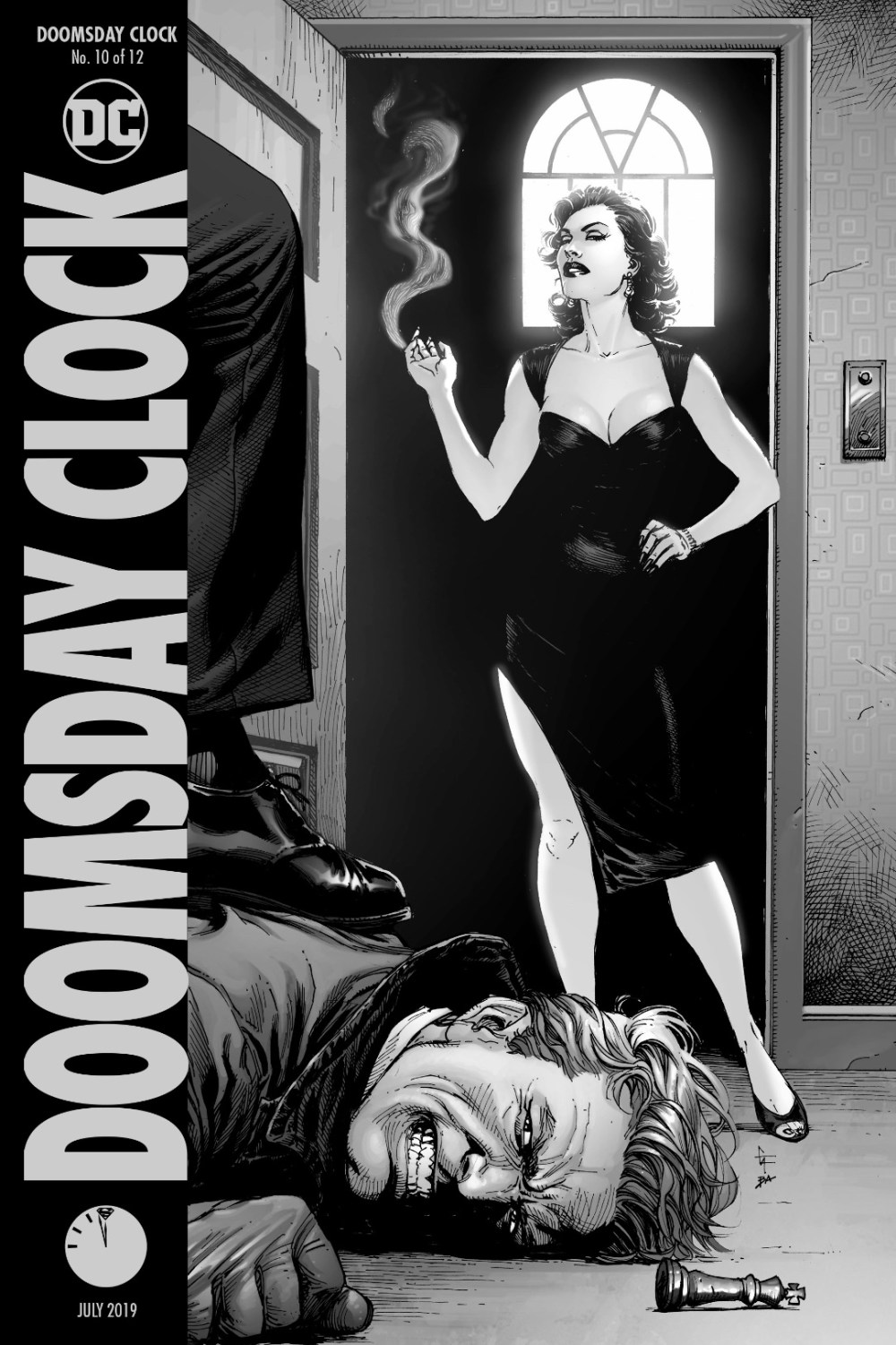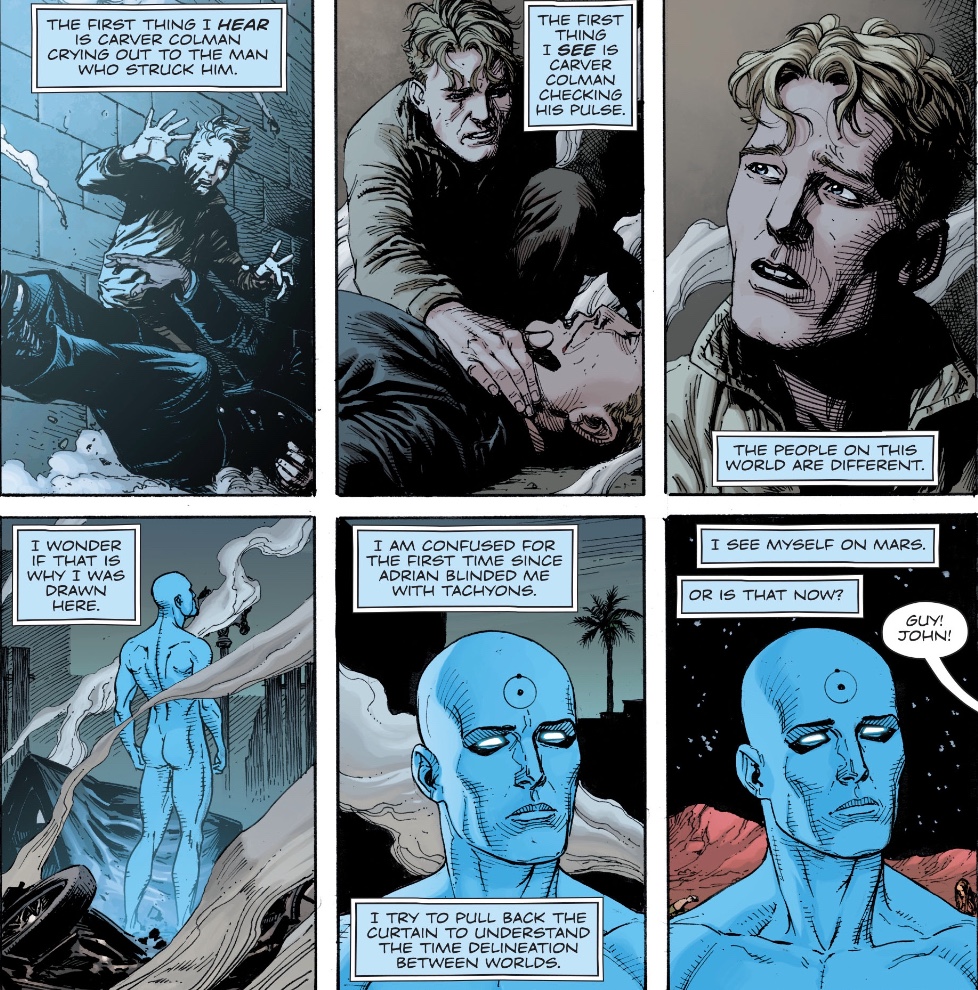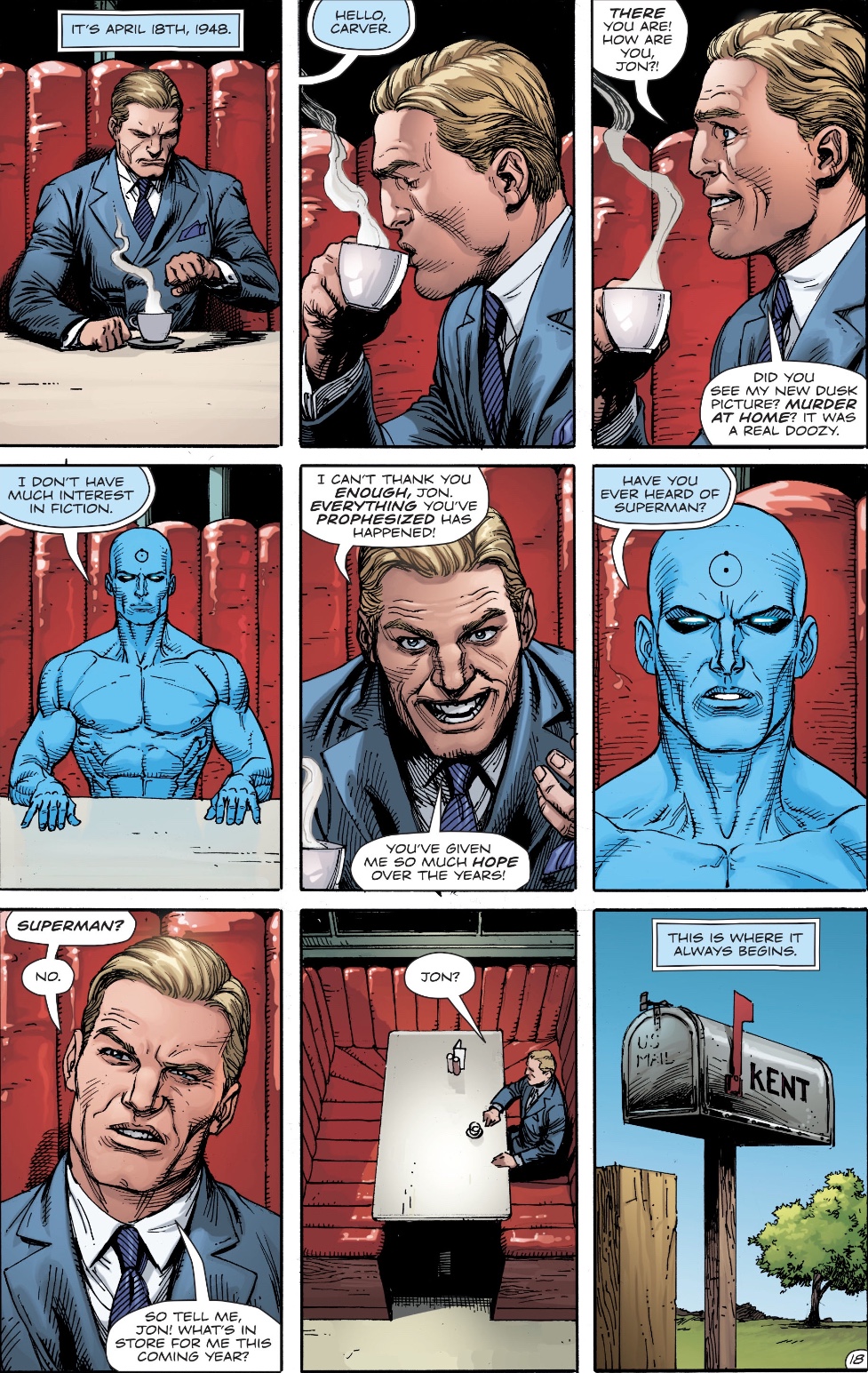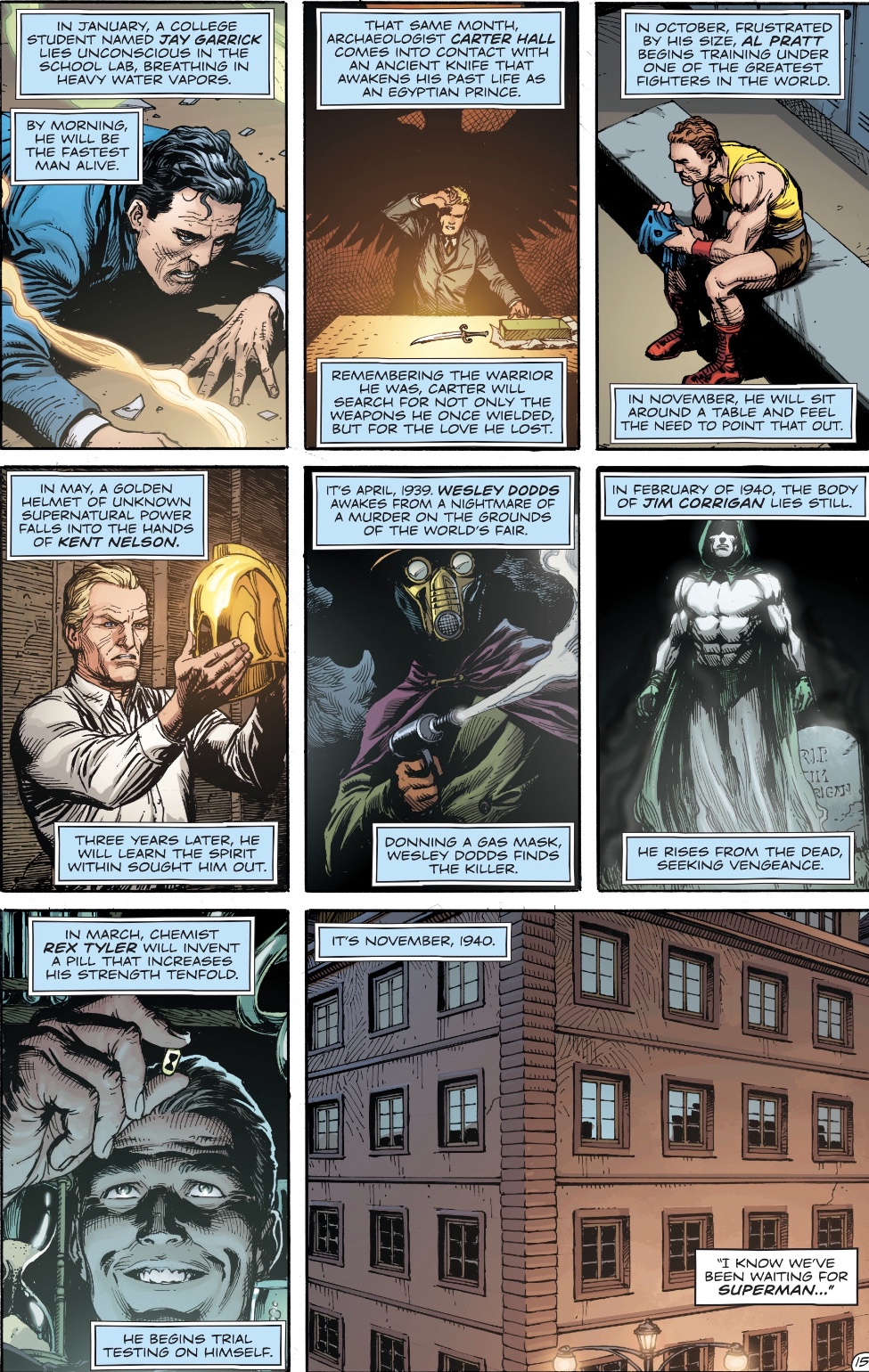
It’s April 18 1938, the day of Superman’s first public appearance in Metropolis. It’s also the day Carver Colman, a young drifter in Los Angeles, meets Dr Manhattan.

The superbeing once known as Jon Osterman has abandoned his own reality to explore new ones. In this one, though, he’s no longer able to control his ability to travel through time.
The fixed point to which he always returns is Carver who, as the years pass, becomes the star of the Nathaniel Dusk movie series. He’s not able to relax and enjoy his success, though, as his estranged mother constantly threatens to expose her gay son to the press, ending his career.
Dr Manhattan asks Carver to call him ‘Jon’, and they become friends, with Jon giving him snippets about his future. One day Carver intrigues Jon with his answer to a question.

Why doesn’t he know of Superman?
As the years come and go, Dr Manhattan realises something.

Superman’s arrival on Earth moves forward in time, at first in 30-year increments, then at shorter intervals. And he realises something else.

Whew! That’s a lot to take in. This issue of Doomsday Clock, a series which has come in for negative criticism by some people for its relaxed pace, explodes DC history. We knew Dr Manhattan had tampered with the DC Universe, here we find out why – scientific curiosity. Why is Superman the lynchpin of his universe? And he sees the bigger picture – Superman’s Earth is the lynchpin of the multiverse, it’s the seed from which all other origin stories, from Krona to the Forger of Worlds, sprout. It is… the Metaverse.
As a reader, I’m left with so many questions. Delicious questions. The shifting forward of Superman’s origins in time on this prime world seems to wipe away the concept of Earth One, Earth Two and so on… it’s all the prime Earth. Or does it? Do the machinations of the likes of the Anti-Monitor and Extant hurt continuity or enrich it? They change the prime Earth, the multiverse reacts and creates a separate Earth to reflect that, one that continues when the prime Earth inevitably shifts once more?
Have I got that? Very possibly not, but I don’t mind if I’m wrong. Just thinking about these things gives me huge pleasure, and in the week of the horror that is the Heroes in Crisis finale, I’m thrilled to see the DC Universe: Rebirth special, in which Wally West realised his world had been changed, brought in… there’s hope that Hope will return to the DC Multiverse. Not the depressing version offered by HiC, but the shining, life-enhancing concept embodied in the original Legion of Super-Heroes whom we see here.
The Rebirth Special also teased important roles for the Legion’s Saturn Girl and the Justice Society of America’s Johnny Thunder, and both cameo here as they have in precious issues. How they’ll link to the story’s conclusion in a couple of months I can’t guess – Johnny has a magical thunderbolt genie, Imra gave birth to a son with mental lightning, Wally gained his powers from a lightning bolt hitting chemicals and looked to a lightning storm as he realised someone was manipulating reality…

Speaking of the JSA, they get a couple of fascinating pages as we see the effect Dr Manhattan had on the history we know, as he plays with lives that seem no more real to him than do folk in a Nathaniel Dusk screenplay. And there’s a development with Carver at the end that either hints at him having something special that drew Jon to him, or that he’s been changed by Jon.
I don’t know and again, I like that I haven’t worked things out. Johns looks to have full control over his material, evidenced by the way in which intricate story elements are beginning to bounce off one another. Like Alan Moore in Watchmen, Johns has to be writing this with charts by his side, but where Watchmen felt like an experiment in storytelling, Doomsday Clock feels more human. Differently brilliant, is all – as Watchmen wouldn’t work without the comics that came before it, Doomsday Clock needs Watchmen. The series complement one another – Johns is so at ease with Moore’s creations that he’s created two new characters, Mime and Marionette, who could have stepped straight out of Watchmen.
And as artist Dave Gibbons was a vital partner in Watchmen, Gary Frank makes Doomsday Clock sing visually. He finds a sweet spot between the DC feel and Gibbons’ vision that perfectly suits Johns’s script so that even when we’re on the gritty backstreets of LA, there’s real wonder. And he does a fine job of keeping Carver recognisable as he ages up and down the timeline. It’s also a treat to see him revisit the Superman: Secret Origin series he created with Johns. Colourist Brad Anderson and letterer Rob Leigh also show why they’re so well-respected at DC, matching the colour palette of Watchmen’s John Higgins and the letters of renaissance Man Gibbons.
As well as the comic strip, we get backmatter: an illuminating letter from Carver’s mom and an excerpt from a Nathaniel Dusk film script. I’m not sure why Johns used the downtrodden detective in this series, but as a fan of DC’s two Eighties Dusk mini-series by legends Don McGregor – who gets a shout-out in the main strip this time – and Gene Colan, I’m thrilled to see the character incorporated into continuity in a sideways manner. It’s a nicely designed bonus feature by Amie Brockway-Metcalf.
I’ve enjoyed Doomsday Clock all the way through, and haven’t been overly perturbed by the delays – a comic of this quality rewards patience. Geoff Johns, Gary Frank and friends have produced, in the words of my mate Anj, ‘a love letter to the DC Universe’. And I’m so glad I got to steam it open.
I really enjoy this too, but the delays do bother me, because while this series seems like it will be a more thoughtful changing of the DC universe, the delays have meant DC has had to tread water with some of the things that Snyder has thrown up all over the universe. Snyder’s Justice League and the whole Source Wall thing he’s been doing has, in my opinion, been filler for something that is going to come from this book, something that will cause the DC universe to either reset or come back to a more recognizable form.
I like the idea that Jon thinks of himself as the Villain because he is so analytical that he would never delude himself. If he sees what he’s done with clear logic, he knows he is the Villain and admits it.
I do wonder why Wonder Woman was not in any of the Justice Society bits. That seems like an odd oversight for someone as detailed as Johns. Is she another linchpin? And what of Batman? He was around during that era too, how are they missing?
Is it possible that Jon messing around with this Prime Earth has created three distinct multiverses in which Superman, Wonder Woman, and Batman become the linchpins to the changes that occur in the rest of the Multiverse?
I wish I could set DC straight on the concept of a multiverse, though. It seems they always struggle with what it actually is, and I think they don’t seem to understand that they already had it right. An infinite Multiverse already contains all of the possibilities, even when they seem to be counterintuitive or to negate each other.
LikeLike
Thanks for some brilliant thoughts! I hadn’t realised that the delays to this are likely why the Snyder JLA is stretching on and on, with all those villain filler issues. The idea that after this series wraps we’ll snap into some – OK, at best medium-term – status quo is great.
Oh boy, I’d not even noticed the lack of Wondy and Bats. Yeah, there must be a plan.
Very fair point about the Multiverse. I have t say, the mere mention of Hypertime made me grin.
LikeLike
Carver was gay? I didn’t get that at all. I thought Carver was violated by the man his mother brought home, and he left the next day, as opposed to his mother putting him out. His mother’s note details what she believes happened, but it’s obvious that she doesn’t care about Carver and sees what she wants.
This was a really a heavy issue. No Superman, no hope, and no Superboy, no Legion of Superheroes i.e. no future!
Excellent review, by the way. Your knowledge of DC’s history makes it sound.
LikeLike
Hmm, I wonder if I’m filling in the blanks of Carver’s secret shame via cliche rather than text… I’m going to have to go back and check, darn. 🙂
I think we’re Talking about the lack of Batman and Wonder Woman generally rather than at the JSA meeting; we might have expected them to be referenced when the origins are listed – they weren’t regular JSA, but they were ‘born around the same time’.
Than you for making me think, I love this!
LikeLike
Hmm, so the letter says his mother found him in his room with ‘Billy’. Was Billy the man she brought home? I assumed he was one of Carver’s peers. Developing…
LikeLike
Batman and Wonder Woman were founding members of the Justice Society of America?
LikeLike
I loved this issue – everything about it, from the glimpses of the JSA and the Legion, to Johns nailing Manhattan’s thoughts, to the labelling of the main DCU as the “metaverse” worked a treat for me. The delays are a shame, but like you said, they’re worth it when the end product is this good.
My only fear is that while this was originally planned to tie in to the main DCU at the end of it, so much has changed – particularly Wally’s treatment in HiC which makes a mockery of his appearance here as the beacon of hope – that DOOMSDAY CLOCK will have little or no impact on the DCU.
I hope I’m wrong.
LikeLike
And more scary intelligence, thanks Gary. I hope you’re wrong too! Poor Wally… I reread – OK, skimmed – the Rebirth Special before writing this review and it really did seem as if his story would have some momentum.
Maybe Impy, Max, Johnny and Jesse will appears to rescue him!
LikeLiked by 1 person
Was what Carver Coleman being blackmailed with explained?
LikeLiked by 1 person
He’s gay. I think it was in the backmatter in an earlier issue. There’s a reference in his mother’s letter this time.
LikeLike
I need to tweak that copy, don’t I?
LikeLike
Here’s my question about this issue. And it’s such a trifling matter. But Johns was so careful about dates and times in this issue with regards to Superman, so why did he set the scene with the Legion in the 31st century, as opposed to the 30th century which is where they ought to have been (according to their first appearance)?
I don’t care if their current adventures (assuming they get some) are set in the 31st century, but shouldn’t their original appearance as documented here in this issue be in the 30th?
LikeLiked by 1 person
It should, but according to the annotated article at CBR he got a few dates wrong throughout the issue.
LikeLike
I’ll have to check that article out.
LikeLike
I’m glad this issue worked so well for you, Mart. This seems like more of the same to me — essentially a cold, intellectual exercise to justify changes throughout DC’s publishing history. It’s interesting and well constructed, but if it’s got a beating heart to it, I’m missing it. (Which might be where the delays really harm my enjoyment–I don’t mind the wait, but the long gaps mean I can’t draw an emotional throughline from one issue to the next.)
That said, it’s SO well executed. I’m glad Johns and Frank are taking the time to give this the love and care they feel for it.
It’s good to see the puzzle pieces starting to click into place, but I’m afraid that even when I see the big picture, and am told why things are the way they are, it won’t matter to me — because whatever the motivations of quantum boogeymen, the real reason behind the changes is, and always will be, publishers trying everything they can do to sell funnybooks.
And wow…that means that Dr. Manhattan has completed the Johns trifecta of meta characters! So many of Johns’s characters are aspects of how comic books are made and received. First came Zoom — essentially a writer, who wanted to make Wally a better hero through giving him hardship. Next came Superboy Prime, the ultimate petulant fan who couldn’t believe what his heroes had been reduced to. And now comes Dr. Manhattan, the living embodiment of a publisher’s whims. Johns has been approaching this theme from different angles for years; this is just the latest version.
LikeLiked by 1 person
That’s rather brilliant, Rob. Get it on Twitter so I can retweet the heck out of it!
LikeLike
Good idea — thanks!
LikeLike
By the way… Hypertime has been mentioned since Rebirth began. Apparently, that’s where the villainous future Tim Drake comes from. I was just reading the walmart reprint of the Super-Sons/Titans/Superman crossover, and one of the first things Drake says when he appears is, “Didn’t think I’d be back so soon. did you? You thought Hypertime swallowed me up?” I don’t remember exactly how Hypertime was used in his first appearance, but it played some sort of part in it.
Hypertime is actually my favorite of the multiverse concepts. It’s a giant handwave, saying “sometimes this stuff all fits together, sometimes it doesn’t.” Ever since its introduction, all the other theories of the multiverse have struck me as over-complicated. Continuity is whatever the current story requires…and everything else is superfluous.
LikeLike
I liked the concept too – I think it was used somewhere apart from the Kesel/Grummett Superboy, but darned if I can recall where!
LikeLike